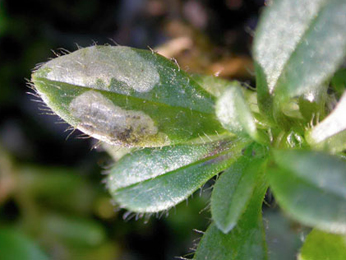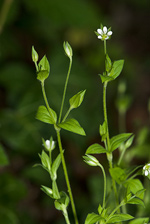|
||||||
|
MOEHRINGIA. Three-nerved Sandwort [Caryophyllaceae] |
|
|
Three-nerved Sandwort (M. trinervia) is the only species of Moehringia recorded in Britain. It is a native species. Seven British miners are recorded on Moehringia. A key to the European miners recorded on Moehringia is provided in Bladmineerders van Europa. |
|
Key for the identification of the known mines of British |
Note: Diptera larvae may live in a corridor mine, a corridor-blotch mine, or a blotch mine, but never in a case, a rolled or folded leaf, a tentiform mine or sandwiched between two more or less circular leaf sections in later instars. Pupation never in a cocoon. All mining Diptera larvae are leg-less maggots without a head capsule (see examples). They never have thoracic or abdominal legs. They do not have chewing mouthparts, although they do have a characteristic cephalo-pharyngeal skeleton (see examples), usually visible internally through the body wall. The larvae lie on their sides within the mine and use their pick-like mouthparts to feed on plant tissue. In some corridor miners frass may lie in two rows on alternate sides of the mine. In order to vacate the mine the fully grown larva cuts an exit slit, which is usually semi-circular (see Liriomyza huidobrensis video). The pupa is formed within the hardened last larval skin or puparium and as a result sheaths enclosing head appendages, wings and legs are not visible externally (see examples). See Key to non-Diptera. |
1a > Leaf and stem miner: Eggs are scattered individually over the leaf upper surface; they are only loosely attached to the plant. The egg shell has a honeycomb structure. The larva begins with first mining one of the top leaves completely out. Next the larva moves down to another leaf, by way of a tunnel made in the stem. In this way several leaves are mined out, completely and full depth. In the attacked part of the plant the stem has become translucent; the damage causes the plant tip to wilt. In the first mines almost no frass is to be found, further down it is deposited in coarse grains. Pupation generally outside the mine (Miles, 1953). |
|
Delia echinata (Seguy, 1923) [Diptera: Anthomyiidae]. |
1b > Stem miner: A shallow external stem-mine (Spencer, 1972b: 29). The mine generally starts as a fine, lower-surface, corridor the seems to end upon a thick vein. In reality the corridor continues by way of the petiole to the stem, where a very long mine is formed in the rind. Frass in widely spaced grains. Pupation within the mine, mostly just above a node; the anterior spiracles penetrate the epidermis. |
|
Ophiomyia melandricaulis Hering, 1943 [Diptera: Agromyzidae]. |
1c > Leaf-miner: Irregular mine, locally shallow, elsewhere much deeper, giving it a mottled appearance. In broadleaved plants the mine often begins as a blotch with stellate extensions, but sometimes as a very fine, shallow corridor. In grasses the mine often begins in the leaf sheath. The frass is very fine-grained, initially scattered, later in aggregates. |
|
|
Hydrellia griseola (Fallén, 1813) [Diptera: Ephydridae]. |
1d > Leaf-miner: A white linear-blotch mine, the linear section sometimes not detectable as it becomes enveloped in later blotch (Spencer, 1976: 162-3, figs 296-7). Upper-surface, less often lower-surface, corridor, followed, and often overrun, by a large blotch. Even when the corridor is overun, it usually remains recognisable in the frass pattern. The mine looks whitish in the field. The blotch does not contain much frass, in the form of small black grains, dispersed and stuck to the floor of the mine. Feeding punctures upper-surface (always?). Pupation outside the mine. A common miner, forming a white linear blotch mine (the blotch may obscure the linear portion of the mine) in both native and garden plants.The mine is also illustrated in the Encyclopedia of Life. Puparium reddish brown |
|
| Amauromyza flavifrons (Meigen, 1840) [Diptera: Agromyzidae]. |
1e > Leaf-miner: Upper side blotch mine beginning with a deeper, almost full depth corridor. Frass grains not in thread-like pieces, irregularly scattered. In the large, later blotch indistinct primary and secondary frass lines are found; the frass accumulated in the middle. Each mine begins with one, rarely two, oval egg shells attached to the leaf underside. Sometimes a number of of young mines, and eggs, on one leaf. The first part of the mine is a tortuous corridor, quickly turning into a large blotch. Most of the blotch is full depth, only some patches are upper-surface, and greenish in transparency. According to the literature copious frass in present in dispersed lumps. In my experience the larva -that then looks very dark- may accumulate all frass in its body. The larva is capable of leaving its mine, and starting a new one elsewhere. These secondary mines can be recognised by the large hole that was made by the larva when entering. Pupation outside the mine. A gallery then a blotch, larger and deeper than Amauromyza flavifrons. In large leaves the mine is upper surface and all in one piece. In small leaves the whole leaf may be covered by a full depth mine with the larva mining several leaves in British leafminers. |
|
Pegomya flavifrons (Walker, 1849) [Diptera: Anthomyiidae]. |
1f > Leaf-miner: Mine a very long and straight corridor, only after a change of leaf, blotch-like. Corridor first following leaf margin, turning round at the apex, then blotch like and running towards the leaf base. Frass often indistinctly delimited and faded, blackish green. |
|
Pegomya holosteae (Hering, 1924) [Diptera: Anthomyiidae]. |
1g > Leaf-miner: The mine starts as a long, narrow, winding corridor running towards the midrib, widening to a blotch. Usually upper-surface, but in small leaves also full-depth parts may occur. The blotch has broad lobes; in their ends most frass is accumulated in the form of green patches or clouds. Sometimes several larvae share mine. Pupation usually in the soil, less often in the leaf (and then generally not in the mine itself but in a small separated mine, that may even be made in the petiole). |
 Mine of Scaptomyza graminum on Cerastium glomeratum Image: © Jean-Yves Baugnée (Bladmineerders van Europa) |
|
Scaptomyza graminum (Fallén, 1823) [Diptera: Drosophilidae]. |
|
Key for the identification of the known mines of British |
Note: The larvae of mining Coleoptera, Hymenoptera and Lepidoptera may live in a corridor mine, a corridor-blotch mine, a blotch mine, a case, a rolled or folded leaf, a tentiform mine or sandwiched between two more or less circular leaf sections in later instars. Larva may pupate in a silk cocoon. The larva may have six legs (although they may be reduced or absent), a head capsule and chewing mouthparts with opposable mandibles (see video of a gracillarid larva feeding). Larvae of Hymenoptera and Lepidoptera usually also have abdominal legs (see examples). Frass, if present, never in two rows. Unless feeding externally from within a case the larva usually vacates the mine by chewing an exit hole. Pupa with visible head appendages, wings and legs which lie in sheaths (see examples). |
1a > Leaf-miner: Initially mining the leaves, but later on spun flowers and seeds. |
|
Caryocolum alsinella (Zeller, 1868) [Lepidoptera: Gelechiidae]. |
1b > Leaf-miner and case-bearer: In autumn the larva makes a short corridor, that widens into a small blotch, out of which the first case is cut. The final case, after hibernation, is a brown, tubular silken case, three-valved, c. 6 cm long, with a mouth angle of about 30°. |
|
Coleophora chalcogrammella Zeller, 1839 [Lepidoptera: Coleophoridae]. |
| Last updated 06-Jul-2019 Brian Pitkin | ||


